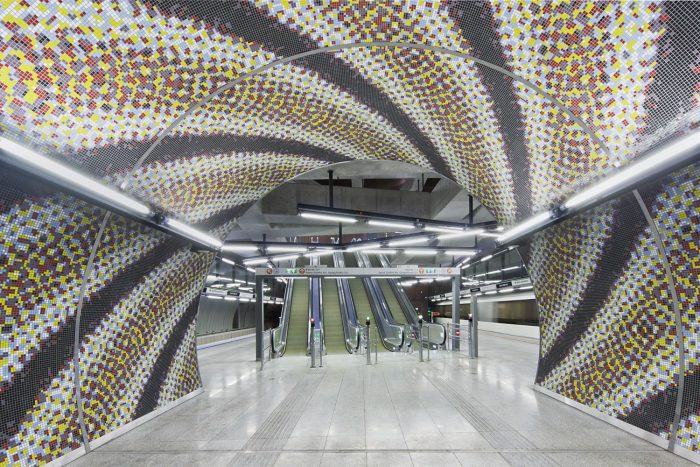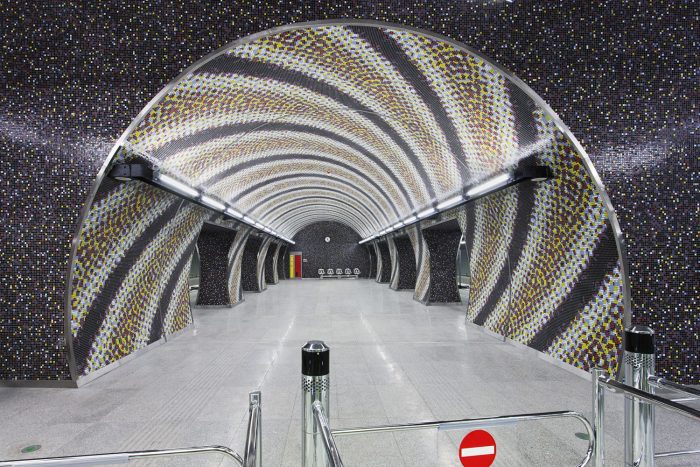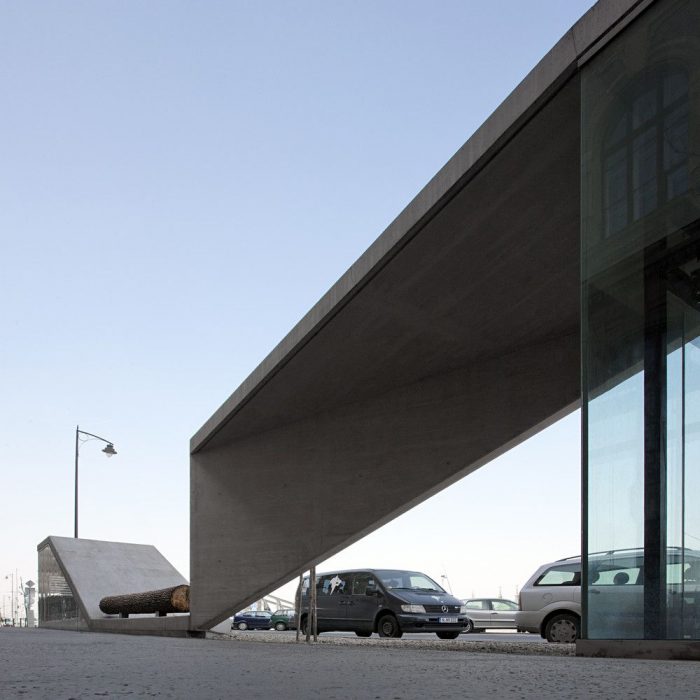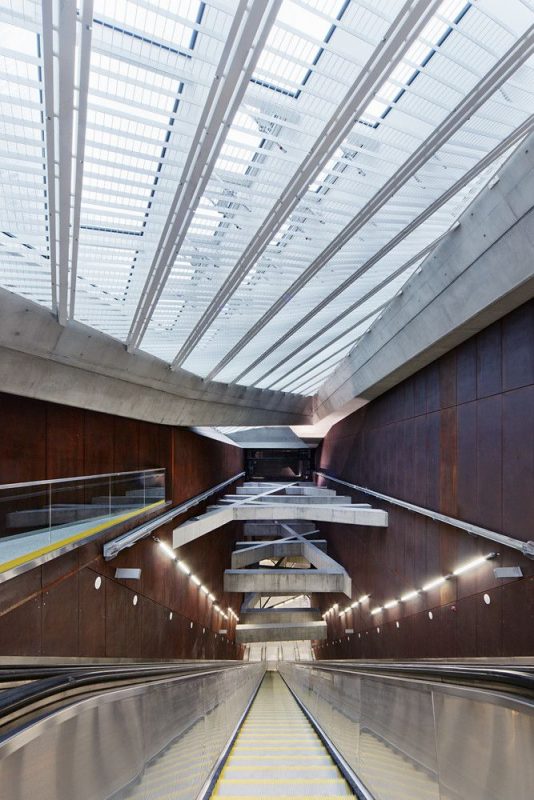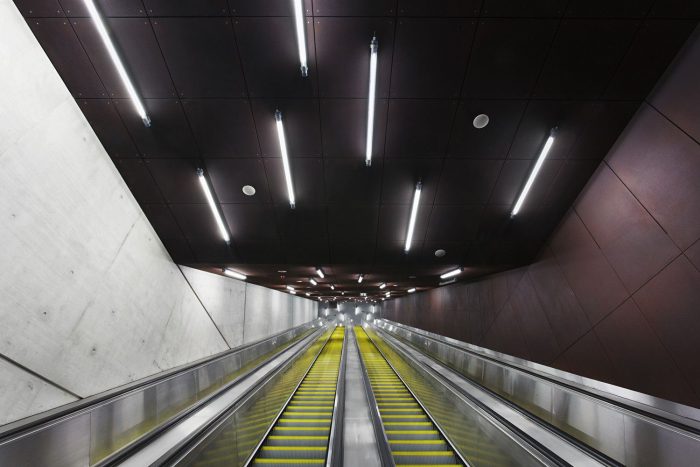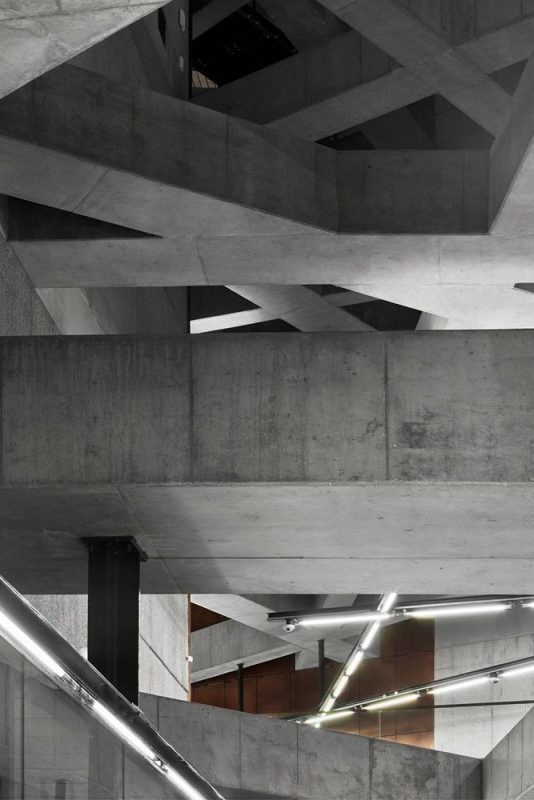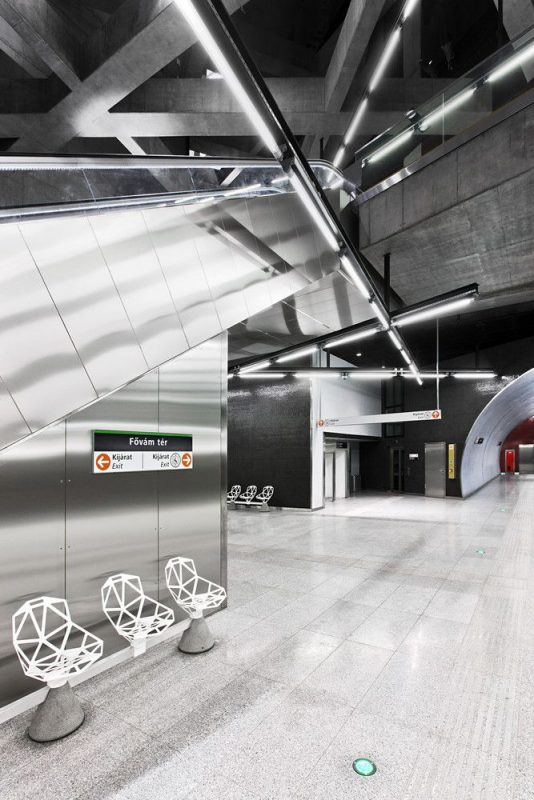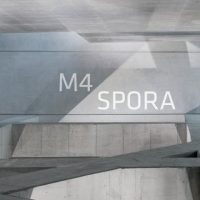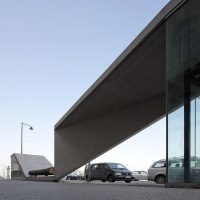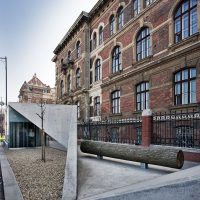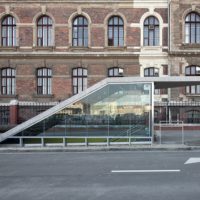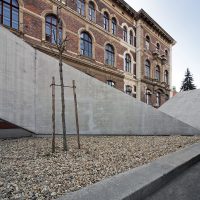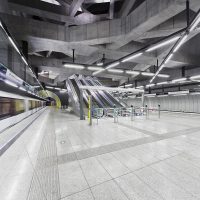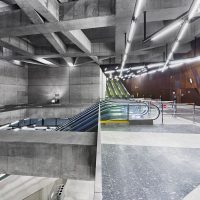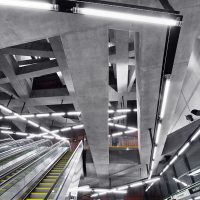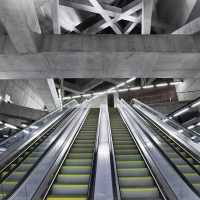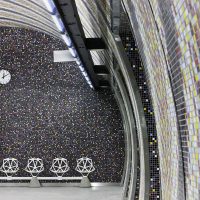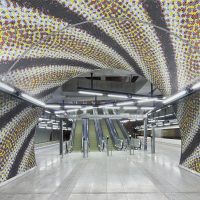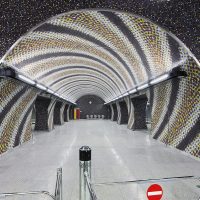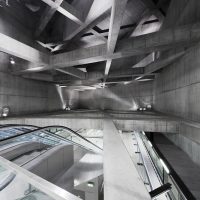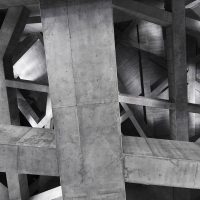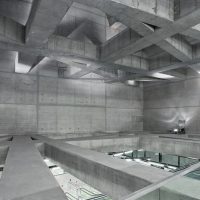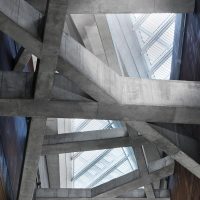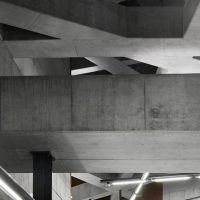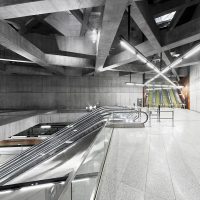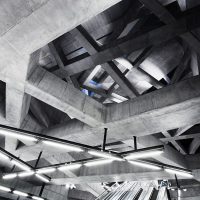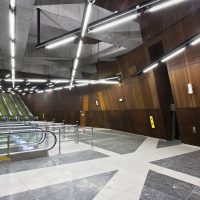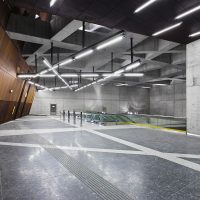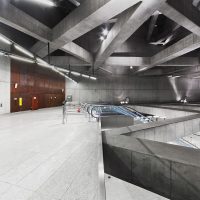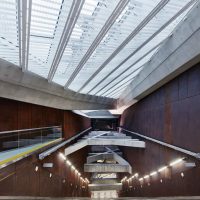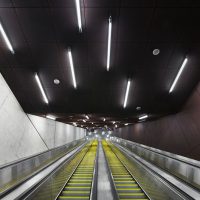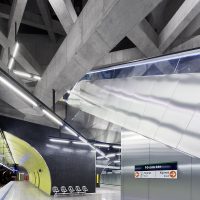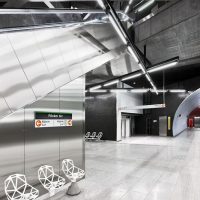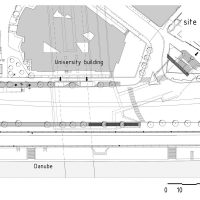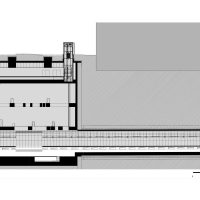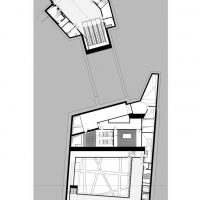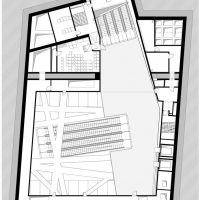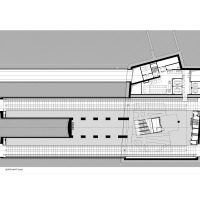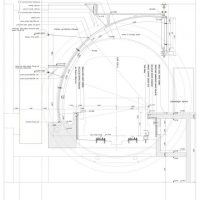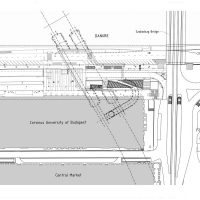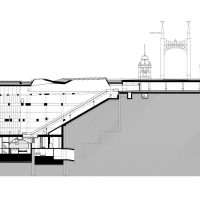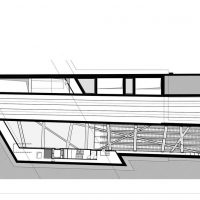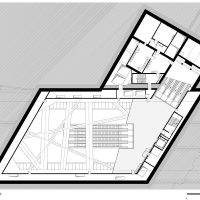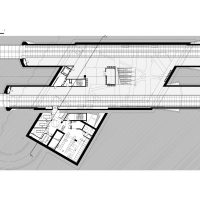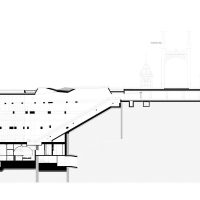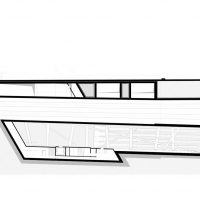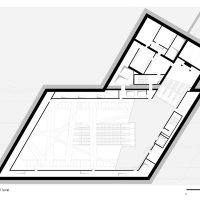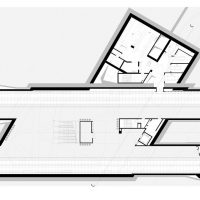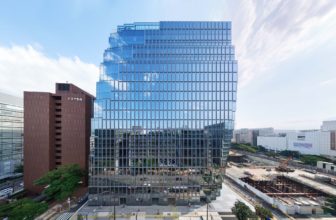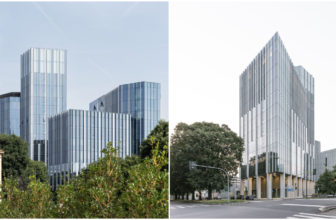Designed by sporaarchitects, Twin Stations – These two metro stations are part of the most important infrastructure project currently in Budapest, the M4 metro line. The original idea of the line was invented by the engineers in the 1980’s, about 30 years ago. It was a metro line designed according to the thinking of that decade. Budapest’s first subway line, the “yellow line” called Kisföldalatti, was opened in 1896. This was the first underground railway in continental Europe and the world’s first electrically powered subway. It had been built in 21 months using the highest level of technology including a prefabricated structure of steel slabs. After a long period of time, there arose the possibility for another line to be built; this was the M2 or “red line”.
The construction began in 1950 during the socialist era; after a long interval, it was completed in 1973. This east-west line was built in a similar manner as the M4 plan, but the stations have been mined. This is typical of metro stations in Budapest. The construction of a new, north-south subway line was initiated in 1970. This was the M3; it was completed in 1990. The missing line, the M4, was conceived about that time, to provide a quick east – southwest public transport connection.
The new M4 metro line planned in Budapest is to connect South-Buda with the city center of Pest which is the heart of Budapest. Ten stations are to be constructed in the first step along the 7,34 km-long line. In the last thirty years, there hasn’t been such an ambitious development in regards to transport here in Budapest. Now, as time has passed, we have faced with a huge gap in technology The concept, thinking and previous plans for the M4 were made in the 80’s and 90’s with stations reflecting the way of thinking of the 70’s and 80’s.
And yet now we will be opening these stations to passengers living well into the 21st century. Thus the most challenging aim for us was to rationalize the structures, architecture, technology, and space as originally planned while at the same time re-thinking the project according to the 21st century’s spirit. One of the goals of the project will be to encourage people to use public transport. We believe that the architectural quality of the stations can be one of the tools used to get people to do this. The metro must be trendy. Budapest is a city of eclecticism, romanticism, and rationalism; it is living in the past. The M4 will be a different world, an underground world. It’s important to emphasize that it’s a public space – a public space under the ground.
The Szent Gellért tér station and the Fővám tér stations are twin stations; both are on the bank of the Danube. They are composed of a cut-and-cover box and tunnels. The box is supported by levels of reinforced concrete beams; the resulting structure is similar to a net, like a bone or skeletal system. The architectural and structural concept based on random beam grid and the underground bone texture combined with the organically implemented construction system was compatible without compromises with the often volatile and changing conditions of the planning and building processes.
The Fővám tér station is more than a metro station; it is a complex traffic junction, an interchange spot for tramways, buses, metro, ships, cars, and pedestrians, which altogether create a unique open public space above and under the ground. The station is a new multilevel city junction, gateway to the historic downtown of Budapest. The section of the underground space is proportional to the cross-section of streets in Pest built in the 19th century. Playing on natural light has been an important aspect of our work; on the surface of Fővám tér we designed crystal shaped skylights over the station which let the sunlight reach the interior.
This project is a construction project conceived by the engineers of the 1980’s which will be realized in the 2010’s and used in the 21st century. It is outdated in many ways. As an architect on this project, how do you proceed? The result of the design process is a Piranesian space above the platform (like Piranesi’s carceri series) which is spectacular. The structure represents the nature of the project on a symbolic level. We can understand this as a horror vacui, structure without content wherein the content is the nothing itself. We simply designed the structure for a pre-determined system intended to expand the line.
The large underground space reflects this evolving stage. What we did was “raise the curtain” to show the structure and space of predetermined building technology. We took advantage of embedded potential; we created a public space under the ground which anybody can continue. The structural and social utopia of Yona Friedmann was also a source of inspiration during our process. It’s important that it is seen to be a public space – a public space under the ground. And public activities are welcome in the stations even during the time of the construction. It is the opportunity of a common ground on which people may share and live and travel.
Project Info:
Architects: sporaarchitects
Location: Budapest, Hungary
Architects in Charge: Tibor Dékány, Sándor Finta, Ádám Hatvani, Orsolya Vadász
Design Team: Zsuzsa Balogh, Attila Korompay project architects, Bence Várhidi, Noémi Soltész, András Jánosi, Diána Molnár, Károly Stefkó
Area: 7100.0 sqm
Project Year: 2014
Photographs: Tamás Bujnovszky
Project Name: Twin Stations
- Photography by © Tamás Bujnovszky
- Photography by © Tamás Bujnovszky
- Photography by © Tamás Bujnovszky
- Photography by © Tamás Bujnovszky
- Photography by © Tamás Bujnovszky
- Photography by © Tamás Bujnovszky
- Photography by © Tamás Bujnovszky
- Photography by © Tamás Bujnovszky
- Photography by © Tamás Bujnovszky
- Photography by © Tamás Bujnovszky
- Photography by © Tamás Bujnovszky
- Photography by © Tamás Bujnovszky
- Photography by © Tamás Bujnovszky
- Photography by © Tamás Bujnovszky
- Photography by © Tamás Bujnovszky
- Photography by © Tamás Bujnovszky
- Photography by © Tamás Bujnovszky
- Photography by © Tamás Bujnovszky
- Photography by © Tamás Bujnovszky
- Photography by © Tamás Bujnovszky
- Photography by © Tamás Bujnovszky
- Photography by © Tamás Bujnovszky
- Photography by © Tamás Bujnovszky
- Photography by © Tamás Bujnovszky
- Photography by © Tamás Bujnovszky
- Photography by © Tamás Bujnovszky
- Gellert Station Site Plan
- Gellert Station Section
- Gellert Station Plan
- Gellert Station Plan
- Gellert Station Plan
- Gellert Station Detail
- Fovam Station Site Plan
- Fovam Station Section
- Fovam Station Section
- Fovam Station Plan
- Fovam Station Plan
- Fovam Station Section
- Fovam Station Section
- Fovam Station Plan
- Fovam Station Plan


